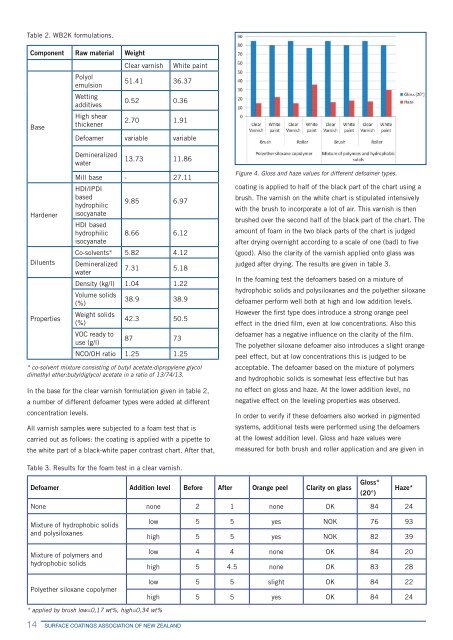Brushstrokes - October 2011 - Surface Coatings Association of New ...
Brushstrokes - October 2011 - Surface Coatings Association of New ...
Brushstrokes - October 2011 - Surface Coatings Association of New ...
Create successful ePaper yourself
Turn your PDF publications into a flip-book with our unique Google optimized e-Paper software.
Table 2. WB2K formulations.<br />
Component Raw material Weight<br />
Clear varnish White paint<br />
Polyol<br />
emulsion<br />
51.41 36.37<br />
Wetting<br />
additives<br />
0.52 0.36<br />
Base<br />
High shear<br />
thickener<br />
2.70 1.91<br />
Defoamer variable variable<br />
Hardener<br />
Diluents<br />
Properties<br />
Demineralized<br />
water<br />
13.73 11.86<br />
Mill base<br />
HDI/IPDI<br />
- 27.11<br />
based<br />
hydrophilic<br />
isocyanate<br />
HDI based<br />
9.85 6.97<br />
hydrophilic<br />
isocyanate<br />
8.66 6.12<br />
Co-solvents* 5.82 4.12<br />
Demineralized<br />
water<br />
7.31 5.18<br />
Density (kg/l) 1.04 1.22<br />
Volume solids<br />
(%)<br />
38.9 38.9<br />
Weight solids<br />
(%)<br />
42.3 50.5<br />
VOC ready to<br />
use (g/l)<br />
87 73<br />
NCO/OH ratio 1.25 1.25<br />
* co-solvent mixture consisting <strong>of</strong> butyl acetate:dipropylene glycol<br />
dimethyl ether:butyldiglycol acetate in a ratio <strong>of</strong> 13/74/13.<br />
In the base for the clear varnish formulation given in table 2,<br />
a number <strong>of</strong> different defoamer types were added at different<br />
concentration levels.<br />
All varnish samples were subjected to a foam test that is<br />
carried out as follows: the coating is applied with a pipette to<br />
the white part <strong>of</strong> a black-white paper contrast chart. After that,<br />
Table 3. Results for the foam test in a clear varnish.<br />
14 SURFACE COATINGS ASSOCIATION OF NEW ZEALAND<br />
coating is applied to half <strong>of</strong> the black part <strong>of</strong> the chart using a<br />
brush. The varnish on the white chart is stipulated intensively<br />
with the brush to incorporate a lot <strong>of</strong> air. This varnish is then<br />
brushed over the second half <strong>of</strong> the black part <strong>of</strong> the chart. The<br />
amount <strong>of</strong> foam in the two black parts <strong>of</strong> the chart is judged<br />
after drying overnight according to a scale <strong>of</strong> one (bad) to five<br />
(good). Also the clarity <strong>of</strong> the varnish applied onto glass was<br />
judged after drying. The results are given in table 3.<br />
In the foaming test the defoamers based on a mixture <strong>of</strong><br />
hydrophobic solids and polysiloxanes and the polyether siloxane<br />
defoamer perform well both at high and low addition levels.<br />
However the first type does introduce a strong orange peel<br />
effect in the dried film, even at low concentrations. Also this<br />
defoamer has a negative influence on the clarity <strong>of</strong> the film.<br />
The polyether siloxane defoamer also introduces a slight orange<br />
peel effect, but at low concentrations this is judged to be<br />
acceptable. The defoamer based on the mixture <strong>of</strong> polymers<br />
and hydrophobic solids is somewhat less effective but has<br />
no effect on gloss and haze. At the lower addition level, no<br />
negative effect on the leveling properties was observed.<br />
In order to verify if these defoamers also worked in pigmented<br />
systems, additional tests were performed using the defoamers<br />
at the lowest addition level. Gloss and haze values were<br />
measured for both brush and roller application and are given in<br />
Defoamer Addition level Before After Orange peel Clarity on glass Gloss*<br />
(20°)<br />
None none 2 1 none OK 84 24<br />
Mixture <strong>of</strong> hydrophobic solids<br />
and polysiloxanes<br />
Mixture <strong>of</strong> polymers and<br />
hydrophobic solids<br />
Polyether siloxane copolymer<br />
* applied by brush low=0,17 wt%, high=0,34 wt%<br />
Figure 4. Gloss and haze values for different defoamer types.<br />
Haze*<br />
low 5 5 yes NOK 76 93<br />
high 5 5 yes NOK 82 39<br />
low 4 4 none OK 84 20<br />
high 5 4.5 none OK 83 28<br />
low 5 5 slight OK 84 22<br />
high 5 5 yes OK 84 24


